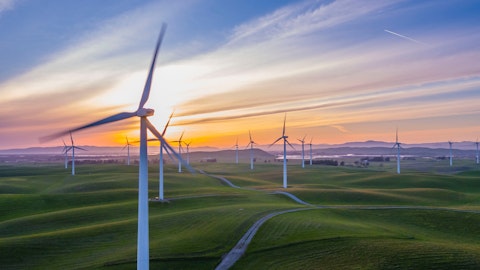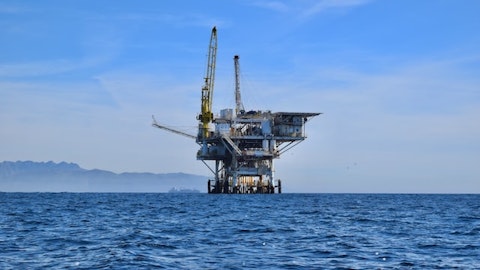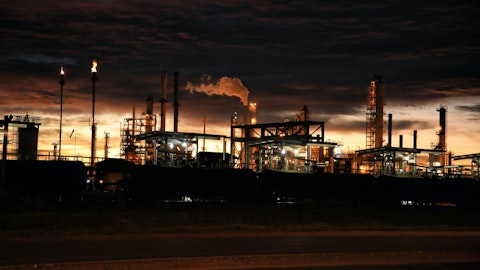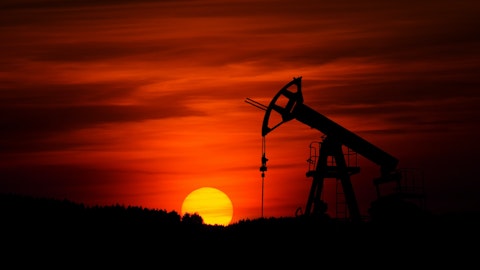Clean Energy Fuels Corp. (NASDAQ:CLNE) Q4 2023 Earnings Call Transcript November 9, 2023
Operator: Good afternoon, ladies and gentlemen, and welcome to the Clean Energy Fuels Third Quarter 2023 Earnings Conference Call. At this time, all lines are in listen-only mode and following the presentation, we will conduct a question-and-answer session. [Operator Instructions] This call is being recorded on Thursday, November 9th, 2023. I would now like to turn the conference call over to Mr. Robert Vreeland, CFO. Please go ahead.
Robert Vreeland: Thank you, operator. Earlier this afternoon, Clean Energy released financial results for the third quarter ending September 30, 2023. If you did not receive the release, it is available on the Investor Relations section of the company’s website at www. cleanenergyfuels.com, where the call is also being webcast. There will be a replay available on the website for 30-days. Before we begin, we’d like to remind you that some of the information contained in the news release and on this conference call contains forward-looking statements that involve risks, uncertainties, and assumptions that are difficult to predict. Such forward-looking statements are not a guarantee of performance, and the company’s actual results could differ materially from those contained in such statements.
Several factors that could cause or contribute to such differences are described in detail in the risk factor section of the Clean Energy’s Form 10-Q filed today. These forward-looking statements speak only as of the date of this release. The company undertakes no obligation to publicly update any forward-looking statements or supply new information regarding the circumstances after the date of this release. The company’s non-GAAP, EPS, and adjusted EBITDA will be reviewed on this call and exclude certain expenses that the company’s management does not believe are indicative of the company’s core business operating results. Non-GAAP financial measures should be considered in addition to results prepared in accordance with GAAP and should not be considered as a substitute for or superior to GAAP results.
The directly comparable GAAP information reasons why management uses non-GAAP information, a definition of non-GAAP EPS and adjusted EBITDA, and a reconciliation between these non-gap and gap figures is provided in the company’s press release, which has been furnished to the SEC on Form 8-K today. With that, I will turn the call over to our President and Chief Executive Officer, Andrew Littlefair.
Andrew Littlefair: Thank you, Bob. Good afternoon, everyone, and thank you for joining us. I’ll let Bob go into the financial details on the quarter, as this quarter has its share of factors impacting the comparison to a year ago, as well as factors impacting our results for the third quarter of 2023. But at a high level, while our results for the quarter didn’t quite reach our expectations, there was also nothing new occurring within our business of any significant consequence impacting our prospects. Key strategic milestones are being executed and we do not see any obstacles in the near-term. Frankly, in a slightly off quarter, we still produce adjusted EBITDA of $14.2 million, which equates to $57 million on an annual run rate basis.
So with that, I’d like to focus my comments on the progress we’re making across many fronts of our business as we put hundreds of millions of dollars to work with plans to deploy well above that. I want to emphasize here that we remain as bullish about the future as we were when we rolled out our comprehensive RNG strategy in early 2022. You know RNG is moving in the right direction. It’s becoming recognized as the most realistic fuel to decarbonize heavy-duty truck. In our opinion, the way the entire alternative fuel market has been moving is only confirmed that we set out on the right plan. We are making investments in the production of our own steady supply of low carbon RNG, while at the same time growing the demand with new customers like Amazon and others that will leverage our national fueling infrastructure.
On the way we’ve been able to secure the best-in-class financial and operational partners through the joint ventures with BP and Total Energies and sustainable capital providers like Riverstone Credit Partners. The confirmation of our strategy by such story names, along with significant investments by other energy majors, pipeline companies, utilities, and large private equity firms in the RNG space is notable as we move forward. I mean, think about it. It is really impressive to me that companies like BP, Chevron, Total, Shell, Enbridge, BlackRock, UPS, WM, Republic, Amazon are all involved in the RNG space. We made good progress on the low carbon RNG production project at dairy’s over the last 18 months. And I hope you saw the press release a few weeks ago announcing that we began injecting RNG into the pipeline in June at our first project, Del Rio dairy in Texas.
We actually began producing RNG in February and stored it until all the regulatory approvals were obtained. But most importantly, we recently began generating both federal and state environmental credits. We made the decision to flow this first RNG from Del Rio to Oregon, where we have stations in demand and the price of Oregon’s LCFS credits is stronger. So this is a great example of why it’s important to have a national fueling infrastructure, which allows us to optimize RNG deliveries for our production projects. We have also begun producing RNG at three other dairies and there are another two projects that are nearing completion and will be producing RNG by the end of the year or early 2024. We will be formally announcing the details of these in the coming weeks.
Some of these dates might have slipped a little from our original plan, but nothing significant. It’s important to note that these are large scale projects, which in this case represent about $184 million of gross deployed capital by us and our partners. You know, these projects are large and they can be a little disruptive at first at the dairies and their normal dairy operations. And they need approvals by several regulatory agencies. So there will be unforeseen delays. But with every project, we have gained important insight and knowledge as being applied to new projects. And we remain on track to meet our overall RNG supply timeline through our own constructed projects and potential acquisitions. The investments we’re putting into R&G supply now will have tremendous value and position us very well for the future.
The enthusiasm I have for our R&G supply business is only matched, if not surpassed, by the demand side. Our base business of fueling tens of thousands of large fleet vehicles every day with R&G continues to grow, providing us with recurring revenue, keeping our balance sheets strong, and allowing us to make the investments for what we believe to be sustainable growth. Much of my optimism is based on one of the most significant advancements that has ever taken place in the R&G technology space. Most of you probably know what I’m talking about, which is the introduction of Cummins new X15-liter natural gas engine that is currently being tested by a handful of some of the country’s largest heavy duty truck freaks. The phrase game changer is probably overused, even by me.
But there’s not a better way to describe this larger engine that Cummins is introducing to the heavy duty market. My 20-years of working very closely with this world-class engine manufacturer, I’ve never heard Cummins speak about another product quite the way they are about this 15-liter engine. Cummins executives are actively promoting the attributes of the engine to investors, their dealers, industry partners and potential customers with the message that this engine has all, superior power, torque, fuel efficiency, and most importantly, the ability to decarbonize heavy duty trucks with RNG on a scale that no other technology is coming close to achieving. It would be one thing if it was only Cummins bragging about a new engine, but they are building on a very successful launch and adoption of it in China where tens of thousands have already been sold.
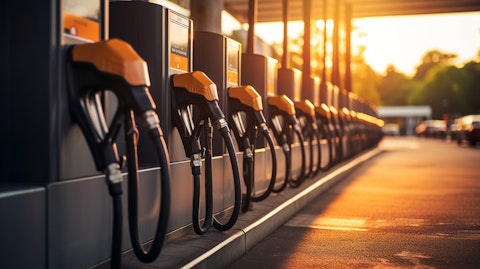
And now we are hearing very positive early feedback from the fleets that are testing it here in the U.S. The fleets that are doing the testing of this 15-liter engine includes some of the country’s most demanding such as Walmart, Warner, UPS, and NightSwift. It would not be overstating to say the reviews have been very impressive. Cummins executive put up a slide at a recent presentation with quotes from the fleet’s likeness. “The drivers love the truck. The engine has a nice pull, it’s very quiet, plenty of torque” “The more they drive it, the better it’s getting all the way around” “It feels and drives like a diesel, which is a good thing” I could go on, but the feedback like this is what is producing the optimism by Cummins and many within the industry like the OEMs that will place it in their trucks.
So much so that for the first time, Cummins is making public their assessment of potential market penetration for the new 15-liter natural gas engine. On the low side, Cummins believes there could be an increase of penetration of the heavy duty natural gas market share by four full from 2% today to over 8% by 2027 and they’re realistic. High case is 12%. Approximately 250,000 heavy duty class A trucks are sold every year in the U.S. And at one case the medium between Cummins low and high cases of 10%, that means 25,000 new heavy duty natural gas trucks can be sold in 2027. Using an average annual fuel usage of 15,000 gallons a year per truck would mean 375 million additional gallons of RNG used incrementally each year. There is no other alternative that could come close to those numbers in the heavy duty space.
Many of the fleets testing the 15-liter do not currently operate many, if any, natural gas trucks. So much of the 25,000 will be coming from new customers. I could go on about the importance of this new engine, but let me close with saying it couldn’t come in a more opportune time. Desire for fleets to decarbonize is only increasing. Yet the technology that some have placed, much hope to get them there, is starting to come under increased scrutiny by the entire transportation industry. And of course, I’m talking about electric. Just in the last few weeks, headline-after-headline has announced the issues that electric is having in the passenger vehicle market. Many within the heavy-duty space are quietly expressing, and some not so quietly, their concerns about the practicality and costs of operating a fleet with much larger batteries and the need for even more powerful charging infrastructure.
RNG continues to be recognized by 100s of the country’s largest transit agencies and refuse companies as an ultra-easy, low-carbon solution that is here today. Soon, with the addition of the 15-liter, the Cummin suite of natural gas offerings, heavy-duty truck fleets that operate under the most extreme conditions will be able to participate in the RNG low-carbon solution. I will reiterate, we strongly believe that the future could not be better for Clean Energy. Our strategy to increase the supply of low-carbon RNG is being well executed, and the almost universal optimism in the new engine technology should be reason for everyone’s confidence. It certainly is for me. And with that, I’ll turn the call over to Bob.
Robert Vreeland: Thank you, Andrew, and good afternoon to everyone. As Andrew mentioned, our financial results came in a little short of our expectations. I want to put that into perspective here. We don’t normally guide to quarters, but I want to tell you where we kind of came in at. For the third quarter, we had forecasted a gap net loss of $24 million, and we are reporting a gap net loss of $26 million. And then we were forecasting an adjusted EBITDA of around $18.6 million, and we are reporting $14.2 million of adjusted EBITDA. Most of this miss was the result of two factors, a much lower LCFS price than what we forecasted and a shortage of R&G from third-parties, as well as our own production. On the positive side, the RIN pricing has exceeded our expectations and remains high today in Q4.
Our base fuel sales margin, exclusive of the Amazon warrant charges and environmental credits, is contributing incrementally to our earnings as we expected. Our Amazon volumes are ramping up as we open more stations and we also had positive operating cash flow for the third quarter as well. So a lot of positive factors in the third quarter even though the results didn’t quite meet the expectations. Regarding our updated guidance, we felt, given the circumstances where the LCFS is at, so principally looking at likely a lower expectation on the LCFS pricing. And considering the impact of the third quarter RNG deficit, we’ve taken our guidance range down slightly. Looking at our results and starting with volumes, I’ll point out that the RNG volume of 56.7 million gallons delivered for the third quarter of 2023 was up 5%, compared to the third quarter last year.
Sequentially, however, we were down 3% from the second quarter of 2023 due to the shortage in RNG that I mentioned. And then also kind of a side note here, looking at our total fuel volumes for 2023, and particularly the conventional natural gas, this is where you’ll see the impact from our Texas LNG plant that’s not been operating, and we’ve talked about some of the drag that that’s caused. Last year, that plant had sold approximately 6 million gasoline gallon equivalents through September, so about 2 million gasoline-gallon equivalents a quarter. So that is impacting kind of the overall story there. Looking at a comparison of revenue, this one always gets kind of interesting, and it certainly is this quarter. We reported $95.6 million of revenue for the third quarter of 2023 versus $125.7 million in the third quarter of 2022.
So that’s a $30 million decline. First, the most notable item is that the third quarter of last year included three quarters of the alternative fuel tax credit which was reinstated as part of the Inflation Reduction Act. So there’s $11 million of retroactive alternative fuel tax credit that’s in the prior year number. And then the Amazon non-cash sales incentive warrant charge, which reduces revenue, is approximately $10 million higher in the third quarter of 2023. And that’s from increased volumes that we’ve had in 2023. And then the third item there finally for the third quarter, the third quarter revenue of 2022 was higher by about $13 million due to the natural gas cost being higher, which then also translates to a higher sales pricing back in 2022.
And that’s a phenomenon that we deal with relative to the natural gas and how that impacts our pricing. But for some context here, though, even though the gas cost in sales pricing was higher in 2022, our base fuel sales margin per gallon, exclusive of the warrant charges, is higher in 2023. So we’ve optimized our retail pricing and gas cost in 2023, and a large part of that’s been the favorable spread that we’ve talked about between the price of oil and therefore the retail price of diesel and natural gas. So that is helping us. It continues to help us, but on a revenue front, it’s lower when the gas costs are lower. Looking at our GAAP operating results, a loss of $21.4 million for the third quarter of 2023. that compares to a GAAP operating loss of $8.6 million a year ago for a $12.8 million decrease.
But of course, that is being influenced by $21 million of a decrease that relates to the alternative fuel tax credit, retroactive credit of $11 million, and then also the Amazon warrant charge that’s up by $10 million. So that’s basically more than takes care of all that decrease. So really the other notable item in our GAAP is that our depreciation and amortization was lower in 2023 by approximately $7.2 million, primarily because 2022 included some incremental depreciation on certain station assets. Our adjusted EBITDA of $14.2 million in the third quarter of 2023, compares to adjusted EBITDA of $23.9 million for the third quarter of 2022, or a decrease of $9.7 million. Again, the $11 million of the retroactive alternative fuel tax credit is included in that prior year number.
If you were to exclude that, the 2022 third quarter adjusted EBITDA would be $12.9 million, compared to the $14.2 million in 2023. And that improvement there is really our fuel volume growth and the underlying base fuel sales margins continue to add incrementally to our results, which has helped to offset the effect of a lower LCFS credit pricing and a lower net take on the RIN. It’s and also some higher operating and equity investment costs in our dairy on vintage. So frankly, the fuel volume and that base fuel margin is working well for us and it always does. The adjusted EBITDA of $14.2 million is comprised of $15.5 million from the distribution business and a negative $1.3 million coming from our dairy RNG production business. On the capital front, we remain on plan with our CapEx spending in the distribution business of approximately $90 million, as well as $40 million in our dairy RNG investment business.
And noting though on that, that with the dairy R&G investments, there is $84 million in cash at our dairy JVs. I think with that, operator will turn the call over to questions.
See also 16 Biggest Lab Grown Meat Companies in 2023 and 20 States That Produce Most Wind Energy.
Q&A Session
Follow Clean Energy Fuels Corp. (NASDAQ:CLNE)
Follow Clean Energy Fuels Corp. (NASDAQ:CLNE)
Operator: Thank you. Ladies and gentlemen, we will now begin the question-and-answer session. [Operator Instructions] And your first question comes from Eric Stine from Craig Hallum. Please go ahead.
Eric Stine: Hi, Andrew. Hi Bob.
Andrew Littlefair: Hi.
Eric Stine: Hi. Can we just dig into the RNG for a second? So, you know, just wondering if you could expand a little bit on the RNG shortages. I mean, I would assume it’s all from third-parties, given that you’ve just started bringing on your own volumes. So maybe some of the things you saw in the quarter and have you seen that more normalized here in Q4?
Andrew Littlefair: Yes, I may go start, but Eric, yes, it was actually, from what we were forecasting, there was both supply, as well as our own production we thought we’d have a little bit more of. But on the supply side, I’m going to say it’s kind of a little bit of normal of the landscape, but there were some low CI projects that were you know just had some startup delays and then some carb — some carb certification delays and so that took down a pretty good number of expected low CI gas. Now, we also, though, had some landfill gas that produced more, and so there’s a bit of an ebb and flow there. The net of it is that we were kind of net, we were net down called maybe a couple million gallons. So this is not huge, but we’re talking about four here and three there and you know netted to two, but what it does do is it does have an impact on the mix, right, on kind of the economic mix and you talk about being short on low CI and making it up on landfill.
But projects that just started a little later, so nothing real fundamental about things aren’t working or shutting down. So, you know, and I mean, just as there’s more and more of it, you know, we’ll kind of get past some of these, when 2 million or 3 million gallons makes a difference. But, you know, We’re not dealing with huge numbers here, but that did impact, say, our net take on the RIN, the LCF as well as the values on the LCFS. On our production side, we were anticipating that we could have more than just the Del Rio that would be contributing and maybe monetizing some biogas in the quarter. Now, maybe not a lot, but enough to defray some of the cost and those are as Andrew said they’re kind of producing gas now, but we didn’t monetize it so we put it together and there was a bit of an impact that I call it kind of timing you know…
Eric Stine: Okay.
Andrew Littlefair: …nothing for us fundamentally don’t worry about it’s a little bit of nature of the beast, but…
Eric Stine: Yes. Okay and so then when you talk about in the release, just a lower share of RIN values. So that also refers then to you just had values that did not reflect some a greater mix of low CI and therefore you had a lower share of it. I mean, just to confirm, I mean, nothing’s changed in terms of your share as the downstream avenue to the fuel tank or anything. It simply is that mix issue.
Andrew Littlefair: It is. It is. Because each supply deal kind of has its own negotiated take and as that starts to move around or it’s short, it could be short where a take is higher or not. And so that’s ultimately how it shows up. It looks like a lower take, but it’s really kind of how much we ultimately earn based on the mix of all the gas and the suppliers that were flowing through our network.
Eric Stine: Yes. Okay. Maybe a good segue just in terms of the upstream progress, so it sounds like you’re basically, maybe a little delayed, but on track for the six to be producing gas here by the end of 2023. Just curious, I think in the past you’ve talked about, gosh, I don’t know if it’s eight in ‘24, and a pipeline of 15-plus, just curious if anything’s changed there, details would be great.
Andrew Littlefair: Yes. You know, Eric, I’d say it’s generally the same, and you’re right. We still see that we’ll be on track by the end of the year. Now, I did, you’ll notice, I did slip into early ‘24 with one of those, right? So, but it’s going to go almost exactly as we’ve discussed, that those six will be finished, and one may slide in there a few weeks. But those will be on production, and we’ll have something out soon on three of them, alright? Now, for 2024, you’ll have, it’s essentially the same numbers as we discussed. It’s actually a little larger. So you can slice these as we’ve discussed before a couple different ways. But you’ll essentially have one that’s in construction as we speak, that will continue to be in construction in 2024.
You’ll have four more that’ll come on in construction. Then right now we have seven, 7/8 that are in the final throws of design, engineering, and a few of those, a couple of those will be on production, not on production, but in construction. So it’s tracking is exactly where we saw it, that you’ll have a few come on for the latter part of the year. And then our pipeline continues to be similar. It’s in the double-digits. Those ebb and flow, but don’t be surprised that somewhere in the year some of those will come on and kind of change our numbers. So I would say Eric is about as many as we can handle right now. And it’s going as expected. So we’re feeling really good about that. We’re beginning to do even more of the work ourself and we’re beginning to bring more of the operations of that as we contemplate these projects in-house.
So we’re really getting more and more comfortable as we cut our teeth on these early projects on how the future — how we develop these projects.
Eric Stine: Okay, thank you.
Operator: Thank you And your next question comes from Rob Brown from Lake Street Capital Markets. Please go ahead.
Rob Brown: Hi, good afternoon.
Robert Vreeland: Hi, Rob.
Andrew Littlefair: Hi, Rob.
Rob Brown: What are your — sense of the — hi. The run rate on the RNG production facilities when you get those six kind of up and running, what’s the run rate in terms of gallons and how does that, I’m sure it does help the shortages, but sense of what that does in terms of volume?
Robert Vreeland: Well, the — you’re looking, I don’t know, 7 million to 10 million for maybe the ones that we’re talking about that go into production, or that go into that, you know, come online by the end of the year. And then others that we talked about that will go into construction and as they produce. They all vary, but I mean, you know, art. So we’re looking, I guess, in kind of a 10 to 20 million gallon range as we’ve talked about. And these things will take a little time getting up. So I think they’ll produce more as we move through. So you could be on an exit rate that’s a higher number even as we go through ‘24.
